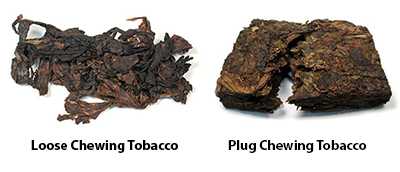Smokeless Tobacco: Products and Marketing
Smokeless tobacco:
- Is not burned1
- Includes tobacco that can be sucked or chewed1
- Can be spit or swallowed, depending on the product1
- Can be spitless, depending on the product2
- Contains nicotine and is addictive1
- May appeal to youth because it comes in flavors such as cinnamon, berry, vanilla, and apple3,4
Types of smokeless tobacco:
- Chewing tobacco (loose leaf, plug, or twist and may come in flavors)1
- Snuff (moist, dry, or in packets [U.S. snus])1
- Dissolvables (lozenges, sticks, strips, orbs)3
Smokeless tobacco is not a safe alternative to smoking. Learn more about these products.
Chewing Tobacco
Chewing tobacco comes in the form of loose leaf, plug, or twist1

| Form | Description | Use | Market Share (in 2011)*5 |
|---|---|---|---|
| *Market share is the percentage of the U.S. smokeless tobacco market for a specific product. For example, almost 2 of every 10 smokeless products (17.5%) sold in the United States in 2011 were loose-leaf smokeless tobacco products.5 | |||
| Loose leaf | Cured (aged) tobacco, typically sweetened and packaged in foil pouches | Piece taken from pouch and placed between cheek and gums | 17.5% |
| Plug | Cured tobacco leaves pressed together into a cake or "plug" form and wrapped in a tobacco leaf | Piece taken from pouch and placed between cheek and gums | 0.5% |
| Twist or roll | Cured (aged) tobacco leaves twisted together like a rope | Piece cut off from twist and placed between cheek and gums | 0.2% |
Snuff
Snuff is finely ground tobacco that can be dry, moist, or packaged in pouches or packets (dip, U.S. snus).2,4
- Some types of snuff are sniffed or inhaled into the nose; other types are placed in the mouth.
- Snus is a newer form of moist snuff used in the United States.

| Form | Description | Use | Market Share (in 2011)*5 |
|---|---|---|---|
| *Market share is the percentage of the U.S. smokeless tobacco market for a specific product. For example, more than 8 of every 10 snuff products sold in the United States in 2011 were moist snuff products.5 | |||
| Moist | Cured (aged) and fermented tobacco processed into fine particles and often packaged in round cans | Pinch or "dip" is placed between cheek or lip and gums; requires spitting | 80.7% |
| Dry | Fire-cured tobacco in powder form | Pinch of powder is put in the mouth or inhaled through the nose; may require spitting | 1.1% |
| U.S. snus | Moist snuff packaged in ready-to-use pouches that resemble small tea bags | Pouch is placed between cheek or teeth and gums; does not require spitting | Data unavailable |
Other Tobacco Products That Are Not Burned
Dissolvables are finely ground tobacco pressed into shapes such as tablets, sticks, or strips.3
- Dissolvable tobacco products slowly dissolve in the mouth.
- These products may appeal to youth because they come in attractive packaging, look like candy or small mints, and can be easily hidden from view.
| Form | Description | Market Share (in 2011) |
|---|---|---|
| Lozenges | Resemble pellets or tablets | Data unavailable |
| Orbs | Resemble small mints | Data unavailable |
| Sticks | Have a toothpick-like appearance | Data unavailable |
| Strips | Thin sheets that work like dissolvable breath strips or medication strips | Data unavailable |
Marketing Information
Some cigarette companies now make and sell smokeless tobacco products.2
- In 2014, more than $600 million was spent on advertising and promotion of smokeless tobacco products.6
- Some cigarette companies advertise that smokeless tobacco can be used in places where tobacco smoking is not allowed.7
- Additional research is needed to examine long-term effects of newer smokeless tobacco products, such as dissolvables and U.S. snus.
References
- World Health Organization. IARC Monographs on the Evaluation of Carcinogenic Risks to Humans. Volume 89: Smokeless Tobacco and Some Tobacco-Specific N-Nitrosamines [PDF–3.18 MB]. Lyon (France): World Health Organization, International Agency for Research on Cancer, 2007 [accessed 2016 Dec 8].
- Mejia AB, Ling PM. Tobacco Industry Consumer Research on Smokeless Tobacco Users and Product Development. American Journal of Public Health 2010;100(1):78–87 [cited 2016 Dec 8].
- U.S. Department of Health and Human Services. Preventing Tobacco Use Among Youth and Young Adults: A Report of the Surgeon General. Atlanta: U.S. Department of Health and Human Services, Centers for Disease Control and Prevention, National Center for Chronic Disease Prevention and Health Promotion, Office on Smoking and Health, 2012 [accessed 2016 Dec 8].
- Campaign for Tobacco-Free Kids. Smokeless Tobacco and Kids[PDF–4.87 MB]. [accessed 2016 Dec 8].
- Maxwell JC. The Maxwell Report. The Smokeless Tobacco Industry in 2011. Richmond (VA): John C. Maxwell, Jr., 2013 [cited 2016 Dec 8].
- Federal Trade Commission. Federal Trade Commission Smokeless Tobacco Report for 2014[PDF–563.53 KB]. Washington: Federal Trade Commission, 2016 [accessed 2016 Dec 8].
- Timberlake DS, Pechmann C, Tran SY, Au V. A Content Analysis of Camel Snus Advertisements in Print Media. Nicotine and Tobacco Research 2011;13(6):431–9 [cited 2016 Dec 8].
For Further Information
Centers for Disease Control and Prevention
National Center for Chronic Disease Prevention and Health Promotion
Office on Smoking and Health
E-mail: tobaccoinfo@cdc.gov
Phone: 1-800-CDC-INFO
Media Inquiries: Contact CDC's Office on Smoking and Health press line at 770-488-5493.
- Page last reviewed: December 8, 2016
- Page last updated: December 8, 2016
- Content source:


 ShareCompartir
ShareCompartir